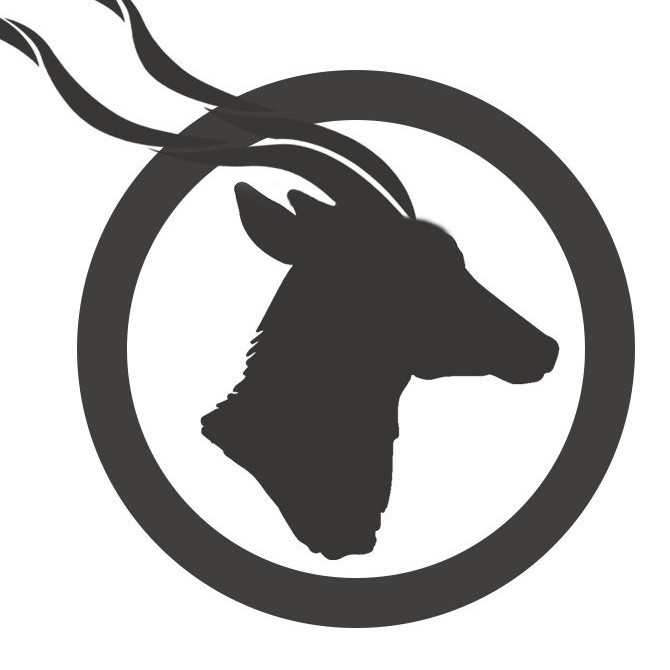Compilation of the original text: Bai Ze Research Institute
Compilation of the original text: Bai Ze Research Institute
"Historical NFT" is a term that describes NFT projects from an earlier period that are "obsolete" or evolved from the NFT ecosystem.
"Internet archaeology" is the study of the history and evolution of the Internet and its various platforms and technologies. It involves examining and documenting the various products and their development that shaped the Internet as we know it today. This may include early chat forums, social media platforms, websites and other internet offerings.
Now, the term "NFT Archeology" (NFT Archeology) has also appeared in the NFT community. "NFT archaeologists" are studying the history and evolution of NFT and sorting out those ancient NFT projects. This involves looking at the early experiments and development of NFTs, and the various platforms and communities that have emerged around them.
In this article, I will try to organize the history of the NFT market (January 2014 - December 2022).
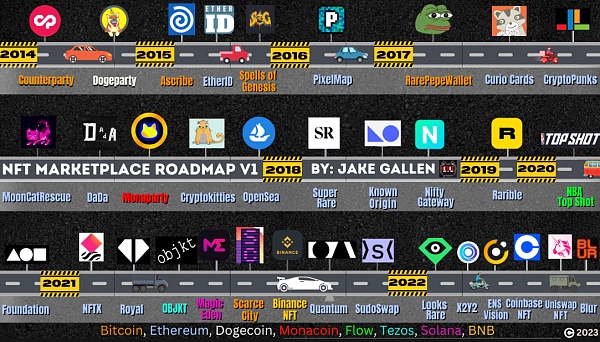
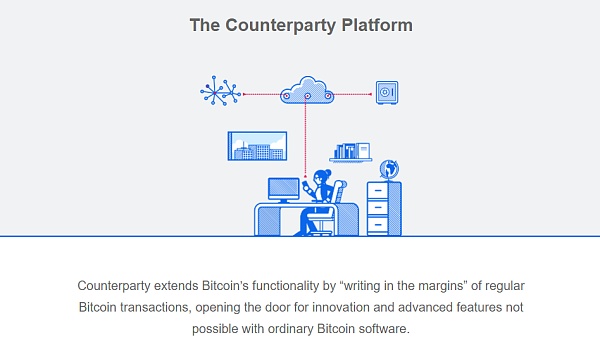
Launched in January 2014, Counterparty aims to be a platform for Bitcoin users to create derivative financial assets and instruments. It became the birthplace of some of the earliest NFTs, such as Spells of Genesis, Rare Pepes, and Sarutobi Island. Counterparty’s native currency, XCP, is created through a mechanism known as “proof-of-burn” – BTC is burned to create XCP. Counterparty's built-in decentralized exchange (DEX) was innovative at the time, predating many DEXs that are common in the blockchain industry today. Counterparty has been unknown for a long time, but it has become popular in recent years, especially during the NFT boom in 2021. Today, it has a thriving ecosystem including XCP Dispensers, Emblem Vault, and Scarce City.

Dogeparty is a fork of Counterparty launched in late 2014 by Adam B. Levine et al. It uses the same "proof-of-burn" mechanism as Counterparty to create its native token, XDP, which requires users to burn Dogecoins in order to receive XDP. Dogecoin’s unlimited inflation protocol made Dogeparty a top choice at the time for some users who wanted to offset an increase in Dogecoin’s supply. Dogeparty was active for about a year before fading into obscurity in 2015. In 2021, the Dogeparty Foundation was established and the project was revived. The project assets are currently available for purchase through XDP Dispensers and Emblem Vault.
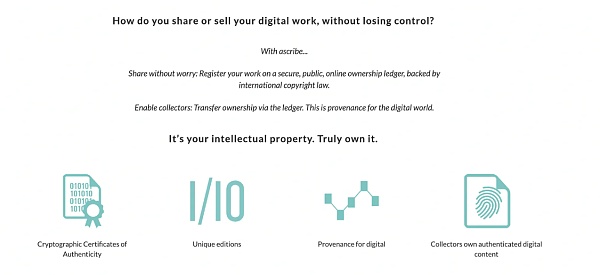
Ascribe is an NFT platform based on the Bitcoin network, operating from 2014 to 2018. It hosts 31,900 tokens for 13,500 users. However, in early 2018, the Ethereum blockchain introduced the ERC-721 standard for NFTs, allowing artists to create their artwork directly on Ethereum. This caused most users to migrate from Ascribe to Ethereum, and eventually, Ascribe decided to shut down its platform. When it shut down, all NFTs on the platform were lost and could not be claimed by anyone. One of the founders of Ascribe said that there may be hope that these "vintage" NFTs can be restored in the future.
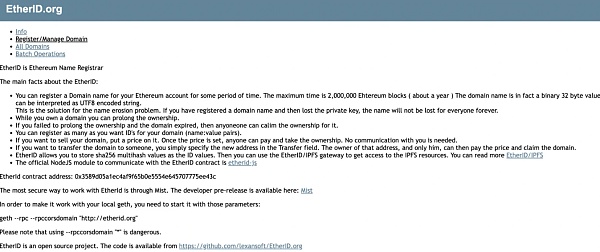
EtherID is an identity protocol launched on November 29, 2015. It is somewhat similar to Namecoin Identities launched in 2012 and Ethereum Name Service (ENS) launched in 2017. A distinctive feature of EtherID is that it has a built-in marketplace that allows users to buy, sell, and transfer identity records to each other. This could be the first NFT marketplace on Ethereum. EtherID is currently available for purchase on OpenSea.
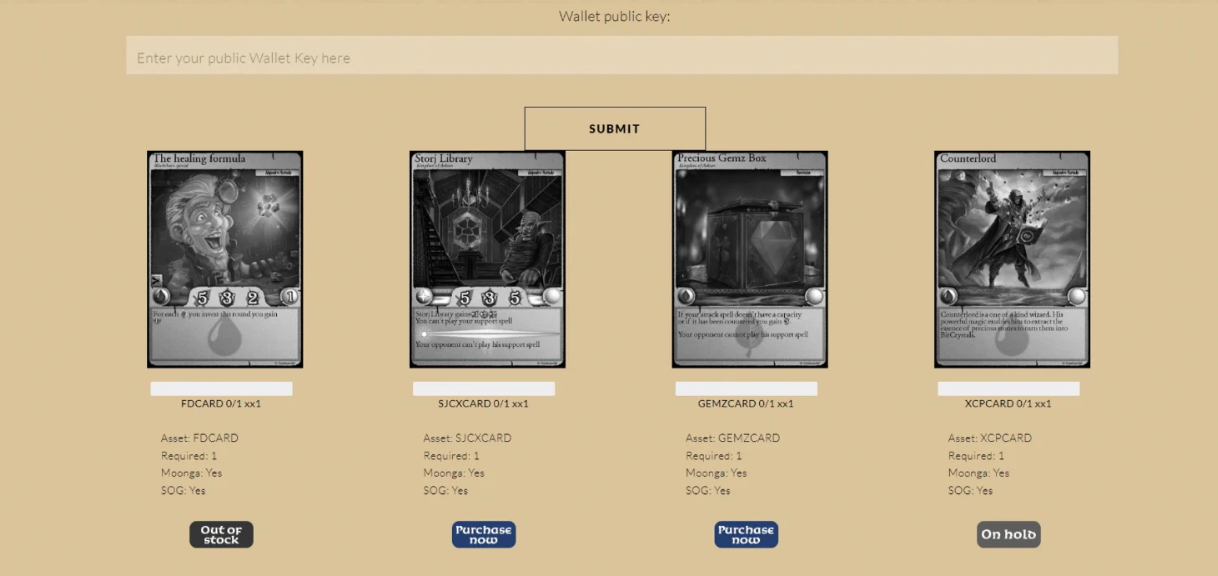
Spells of Genesis (SOG), the first known blockchain game to incorporate NFTs, was developed by Shaban Shaame and EverdreamSoft and launched in 2017. It is a mobile game that combines trading card game (TCG), arcade and fantasy adventure elements. SOG's cards are issued through Counterparty, and once a card's release is locked, it cannot be created anymore. In this way, the authenticity and rarity of the cards can be ensured. SOG assets are currently available viaXCP Dispensers or Emblem VaultBuy.
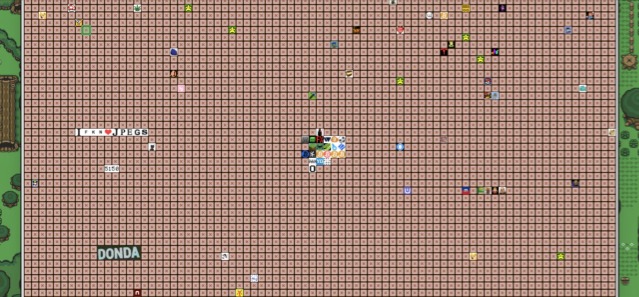
PixelMap is an NFT project created in 2016 by Ken Erwin. It was launched before OpenSea, the first "department store" NFT marketplace, and a year after the ERC-20 (fungible token) standard. During this period, many pre-ERC-721 NFT projects like PixelMap had to have their own marketplaces, which may not be as typical as the ones we see today, however, played a major role in the development of the early NFT industry . Wrapped PixelMap is currently available for purchase on OpenSea.
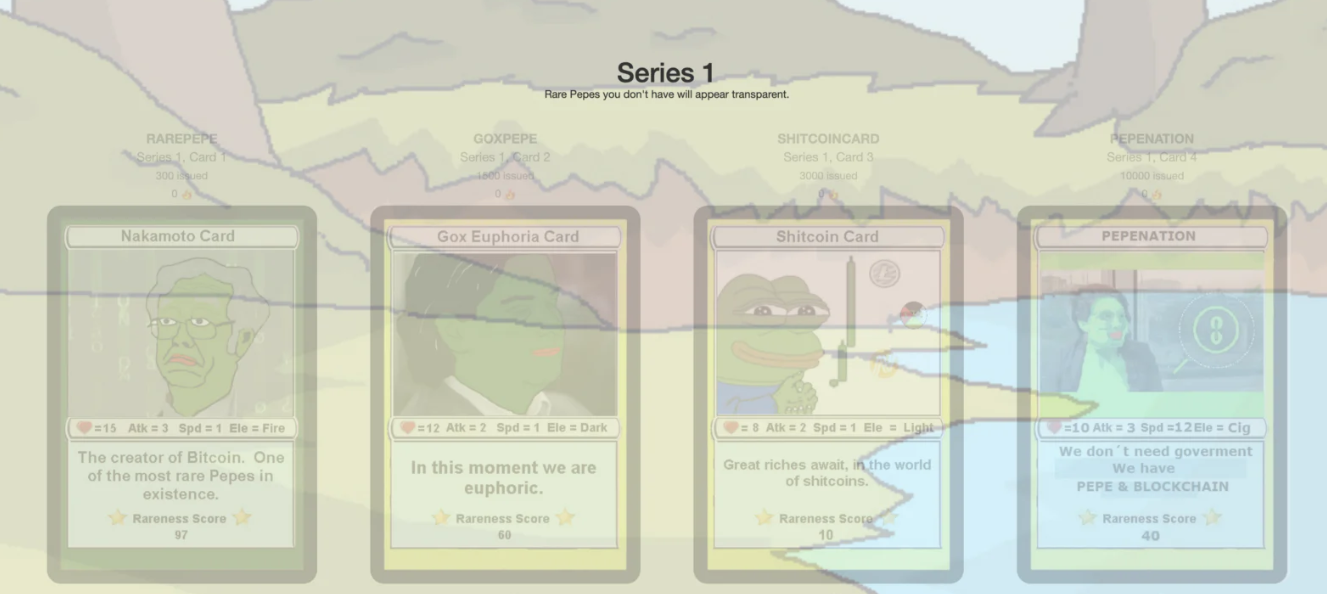
RarePepe is often considered "the birth of crypto art" because of their decentralized origins. What started as a joke in a Telegram group has since grown into a collectible collection of over 300 artists and 1,774 NFTs. After RarePepe launched at Counterparty in September 2016, the community realized they needed a place to store and trade these assets. In response, Joe Looney launched the RarePepe Wallet, which is already live and has become a popular destination for RarePepe collectors. Currently, RarePepe is available for purchase at pepe.wtf, Scarce City, XCP Dispensers, and Emblem Vault.
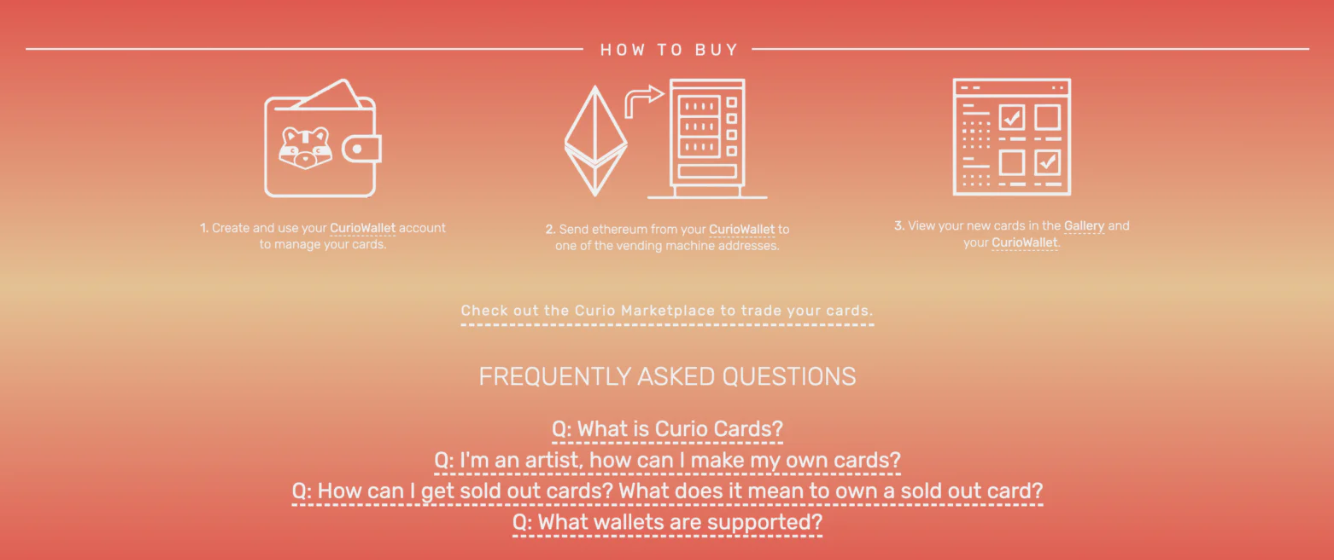
Launched in May 2017, Curio Cards are believed to be the first "Artistic NFT Collection on Ethereum". Unlike RarePepe, which is curated by a group of artists, artists anonymously submit their work to the Curio Cards team, which then sends the submission to the community for a vote before it is used. Curio Cards distribute their NFTs using "vending machines" on their website, each with a supply of cards set by the artist. However, only 31 cards had been released in total for the project at the time, and they didn't fully sell out until 2021, when the project was rediscovered by the wider NFT community. Wrapped Curio Cards are currently available for purchase on Opensea.
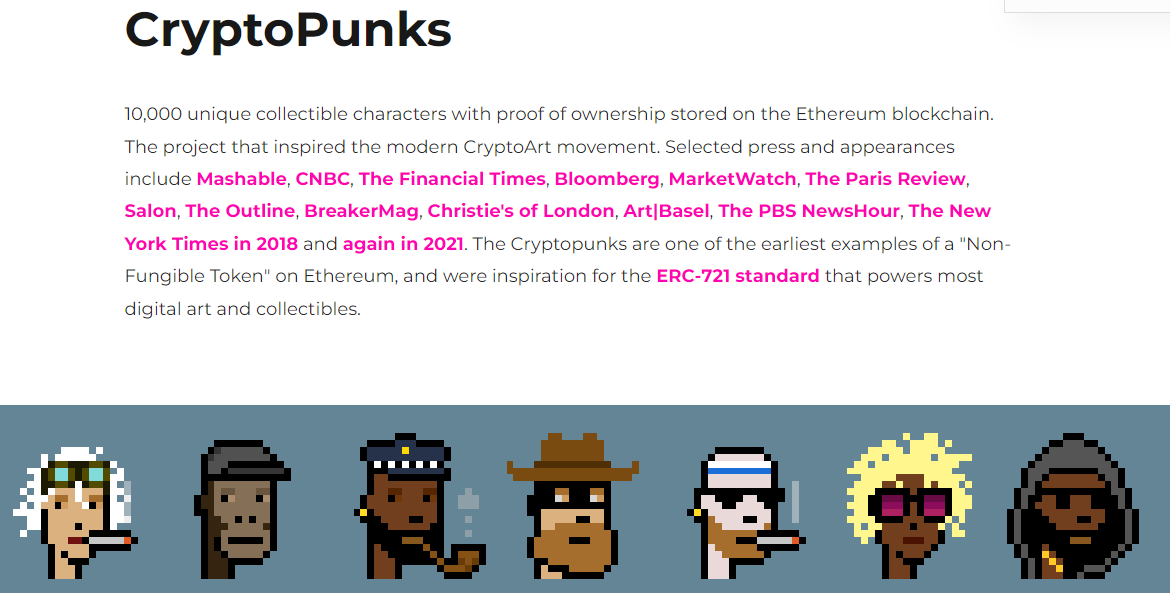
CryptoPunks are widely credited with inspiring many developments in the NFT world, including the Personal Profile Picture (PFP) project, the ERC-721 standard, and a standard supply of 10,000. In addition to these innovations, the CryptoPunks marketplace was groundbreaking and continues to be used today, in part because it was embedded in the V2 code. However, the market has evolved over time. Developer Larva Labs made a series of improvements to the marketplace that resulted in the iconic CryptoPunks brand that is today. Wrapped CryptoPunks V1 is currently available on OpenSea and CryptoPunks V2 is available on CryptoPunks.app.
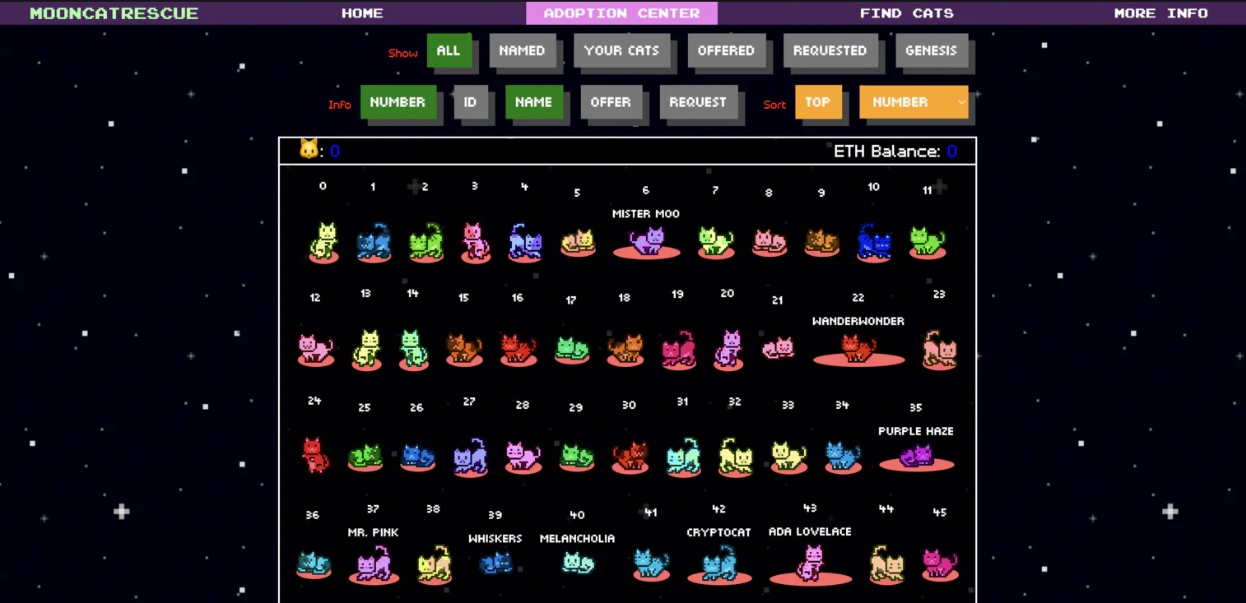
MoonCatRescue was one of the first generative NFT projects, launched by Ponderware in 2017. It allows users to randomly generate over 4 billion cat patterns. The market function of MoonCatRescue is similar to CryptoPunks, and bidders need to deposit ETH into the market contract to bid for MoonCat. Cat owners can sell their cats through the "request" function, accepting bids. Domesticated MoonCats are currently available for purchase on OpenSea.
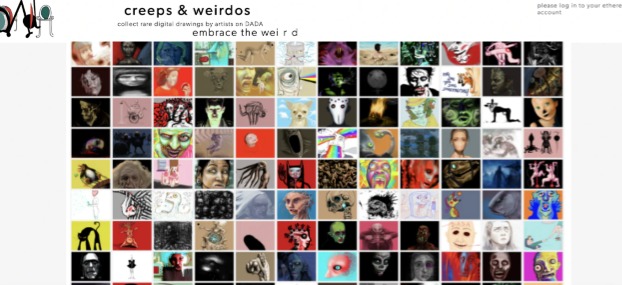
Dada launched their first NFT project Creeps & Weirdos (CW) in 2017 with a built-in marketplace. This marketplace is known for being the first known to offer creator royalties. Before The CW, built-in marketplaces like CryptoPunks and MoonCatRescue offered no royalties to creators. However, OpenSea, launched a few months later, is currently the leader in protecting creators' royalties. Dada's introduction of creator royalties on the CW marketplace may have had a lasting impact on the early NFT industry. Wrapped Creeps and Weirdos are currently available for purchase on Opensea.
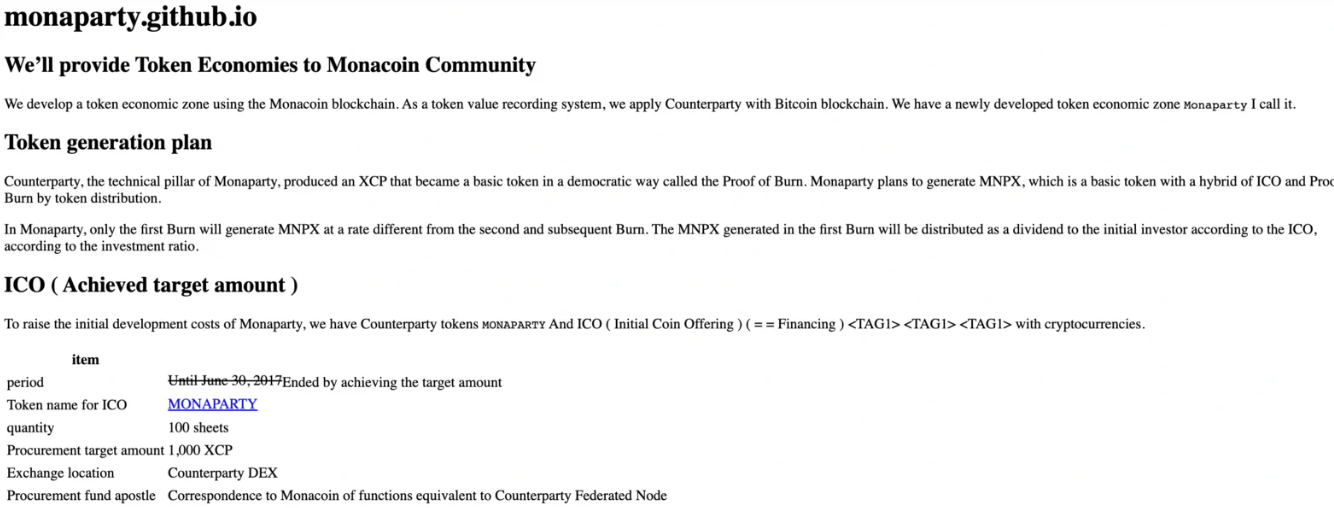
Launched in late 2017 on the Bitcoin sidechain Monacoin, Monaparty is a fork of the Counterparty platform for creating tokens on the Bitcoin blockchain. On January 8, 2018, Monaparty's most popular NFT series, MonaCard, was launched. Like RarePepes, MonaCard is curated by the community and has sold more than 6,000 copies over the past four years. MonaCards are currently available for purchase on Monapallete and Emblem Vault.
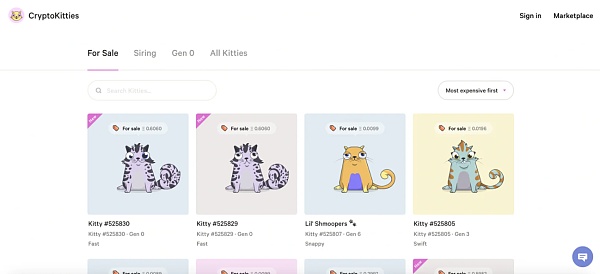
CryptoKitties is an NFT-based blockchain game launched by Dapper Labs on November 23, 2017. Recognized as a pioneer in the NFT industry, it gained massive popularity in 2017 and nearly clogged the Ethereum network with massive cat breeding, buying and selling, and transaction volume. Despite facing competition from other games, CryptoKitties remained popular for a long time and is still widely known today. In addition to being innovative, CryptoKitties' built-in marketplace is known for its user-friendly interface and look, with features like sorting, categories, and more that have been emulated by many other NFT marketplaces. CryptoKitties are currently available for purchase on CryptoKitties' built-in marketplace and on Opensea.
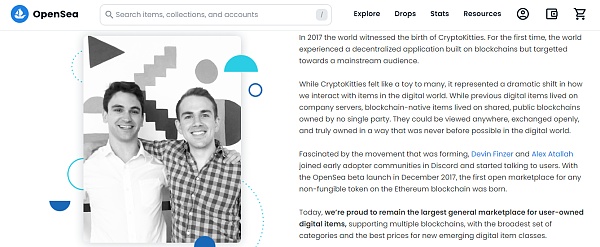
Opensea, a comprehensive NFT marketplace, launched in December 2017 and is the first known marketplace to aggregate NFTs from multiple projects. It listed more than 30 NFTs of different projects just a few months after its launch. At that time, most NFT projects were a mixture of ERC-20 tokens, and it was not until March 2018 that Su Squares, the first ERC-721 fully standardized project, appeared. Only later did OpenSea establish itself as an ERC-721 compliant marketplace. In the five years since its launch, OpenSea has become the leading NFT marketplace on Ethereum and has expanded to other blockchains such as Solana, Polygon, Binance Smart Chain, Avalanche.
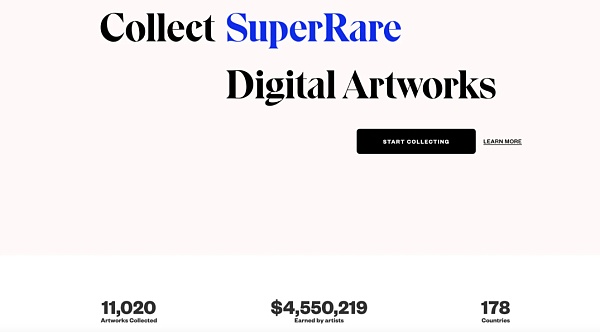
Super Rare, a curated NFT marketplace for artists, launched in April 2018. It was one of the first platforms to implement a whitelist application process for artists. To become a Super Rare artist, individuals must apply and be approved by the platform before they can post their work on a "storefront" of their own design. Super Rare has a standard artist royalty of 10% and has launched an ERC-20 token called RARE (2021) and RarePass (2022).
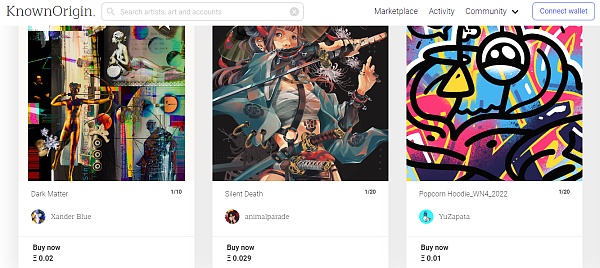
KnownOrigin is an NFT marketplace launched in April 2018 as a platform for artists to identify, showcase and sell their art. This "artist-first" market is similar to Super Rare and competes with it for artists' attention. KnownOrigin was acquired by eBay in June 2022 and continues to operate.
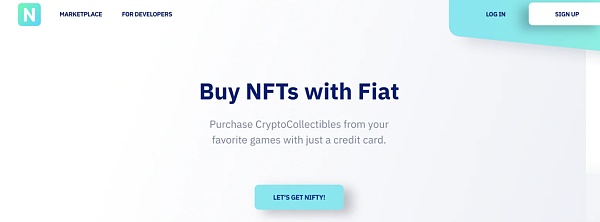
Launched in 2018, Nifty Gateway brought a new feature to the NFT market: NFTs can be purchased with US dollars. This was a significant development as no other NFT marketplace offered this payment option at the time. In 2019, Nifty Gateway stood out from the competition in the NFT market with its NFT auction system and caught the attention of the crypto entrepreneurs the Winklevoss twins, who later that year acquired the platform and integrated it into cryptocurrency trading platform Gemini. Despite facing competition from other marketplaces, Nifty Gateway is currently still the platform of choice for auctioning and issuing NFTs.
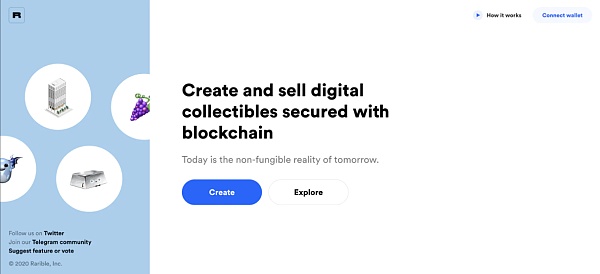
Rarible is an NFT marketplace launched in Winter 2019. Just six months later, it launched RARI, its first-ever native governance token. RARI aims to reward collectors and creators, and envisions a future where Rarible becomes a Decentralized Autonomous Organization (DAO). However, the token is mainly used for "wash trading", where users can conduct "left-handed and right-handed" NFT transactions on the platform, and then receive RARI rewards. Since then, Rarible has transitioned to charging zero fees for users who stake its RARI tokens, and has added support for other blockchains, including Tezos, Solana, and Immutable X.

Foundation is an NFT distribution platform launched in May 2020. It opened its NFT marketplace to the public in February 2021 and offers a unique "invitation-only" system for NFT creators. To create an NFT on the platform, the creator must have an invitation code, which can only be sent by other creators who have already sold at least one NFT on the platform. Collectors can participate in the auction without any restrictions. Foundation is an "artist-centric" platform focused on protecting creator royalties while providing creators with a range of tools and utilities, including an auction system, minting portal, and more.
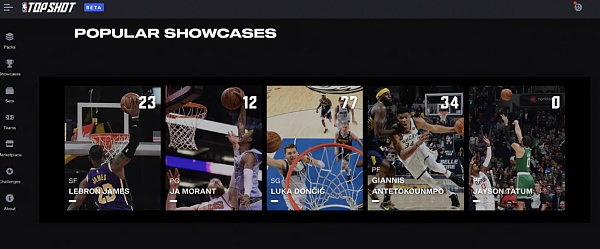
NBA Top Shot is an NFT project released in 2020 on the Flow blockchain by CryptoKitties creator Dapper Labs. The marketplace has categories like Players, Teams, Combos, Challenges, and more. NBA Top Shot is similar to traditional basketball cards, but with moving video instead of static images. The series became popular in early 2021, with some NFTs selling for more than $100,000 and helping thousands of people enter the world of NFTs. Many believe that NBA Top Shot has played an important role in the 2021 NFT boom.
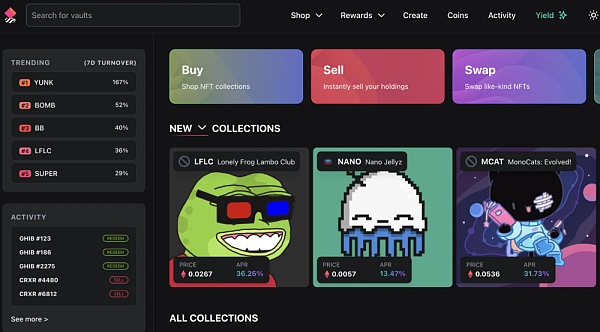
NFTX is an NFT protocol launched in January 2021 by developer Alex Gausman. This is the first agreement to launch an NFT index fund, bringing traditional financial attributes into the NFT world and becoming a real DeFi x NFT product. NFTX allows users to create NFT pools backed by ERC-20 tokens representing instant liquidity quantities in the pool. This is an innovation in the NFT market, as it allows users to buy "fractions" of NFTs using ERC-20 tokens.
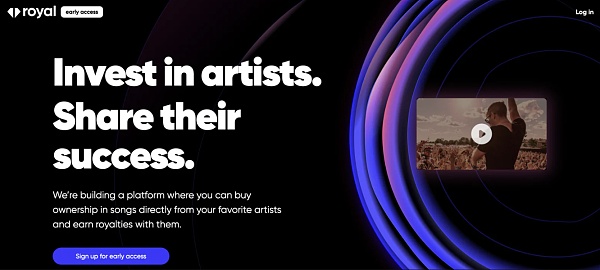
Royal is an NFT marketplace dedicated to music NFTs. It was founded by DJ 3 LAU, a well-known music artist and early NFT pioneer, and launched in early 2021. In just a few months, Royal received more than $16 million in investment from Founders Fund and Paradigm. It's the second category-specific NFT marketplace (after art NFT marketplaces like Super Rare, KnownOrigin, and Foundation) and focuses on music NFTs. Royal aims to change the music industry by using NFT.
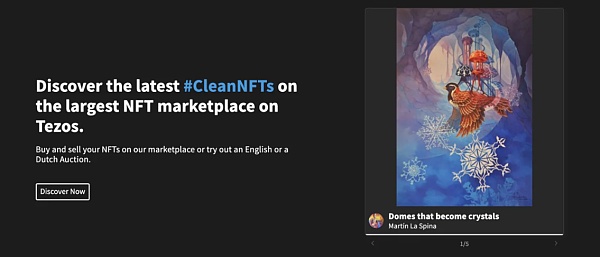
OBJKT is an NFT marketplace launching on the Tezos blockchain in July 2021. It is currently the largest NFT marketplace on Tezos, focusing on artistic NFTs. OBJKT started out as a platform for another Tezos NFT marketplace, Hicetnunc (HEN). But after HEN faced challenges, OBJKT took over to become the leading NFT marketplace on the Tezos blockchain.

Launching in September 2021, Magic Eden (ME) aims to become the premier NFT marketplace on the Solana blockchain. At the time, the Solana ecosystem was thriving and the NFT space was mature. In June 2022, Magic Eden raised $130 million and integrated the platform on the Polygon blockchain. The company plans to become the industry's leading multi-chain NFT marketplace in the future.
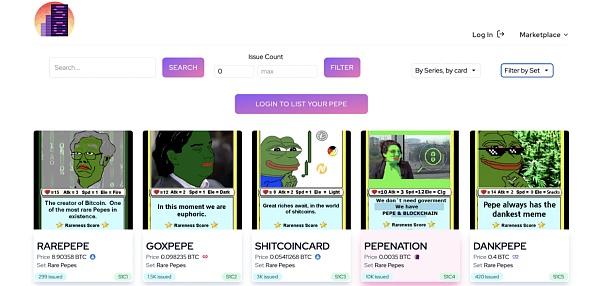
Scarce.City, though a platform launched in late 2020, has a unique history starting as a marketplace for trading physical art and real assets in BTC, utilizing the Bitcoin Lightning Network for low-cost and fast payments. In summer 2021, it launched an NFT marketplace.
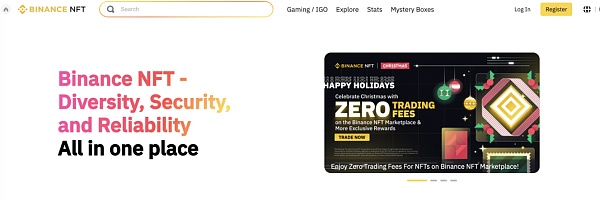
Binance NFT was launched in June 2021 as a way for the Binance ecosystem to support NFTs. The platform has achieved success due to its low fees and user-friendly interface on the BNB Chain (formerly BSC). However, it has also been criticized for the prevalence of scams on the platform and the centralization surrounding the cryptocurrency exchange Binace. Despite these challenges, Binance NFT remains a popular market within Binance’s NFT ecosystem.
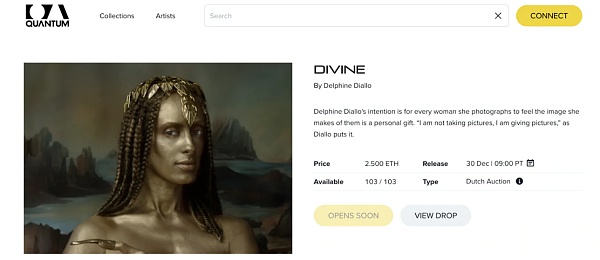
Launched in October 2021 by the famous NFT photography artist Justin Aversano, Quantum is an NFT marketplace focusing on photography NFTs. It aims to attract artists to curate and release NFT collections, and make it easier for collectors to obtain NFT photography. Since its launch, Quantum has expanded to include a brick-and-mortar storefront in Los Angeles and has also added digital art to the platform.
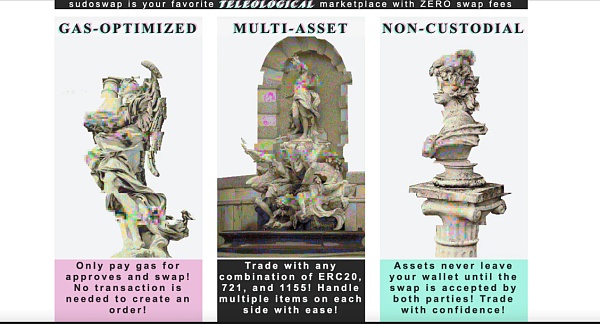
Sudoswap launched in October 2021 as a fully on-chain AMM protocol for NFT transactions. It gained popularity in mid-2022 for offering 0% creator royalties and a low 0.5% marketplace fee. Many traders are looking for ways to protect their funds during these difficult times in the cryptocurrency market, and Sudoswap has received their attention. As Sudoswap gained market share, it caused some confusion in the industry, with some markets following suit, offering 0% royalties, and creators scrambling to quit. Today, Sudoswap is a popular choice for a large number of NFT traders.
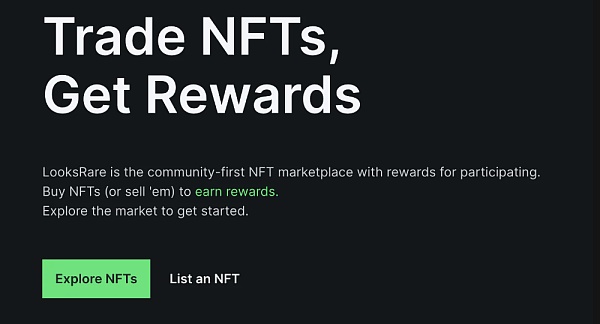
Looks Rare suddenly appeared in January 2022 to conduct a "vampire attack" on OpenSea, airdropping LOOKS tokens to users based on their OpenSea transaction history. This decentralized marketplace gives 100% of transaction fees to buyers, sellers and stakeholders on the platform. In the first 30 days of listing, users tried to get more LOOKS airdrops through wash trading. The completely anonymous team of 40 employees recently announced that it will deploy Looks Rare V2 in the first quarter of 2023, including App version, NFT aggregator and more.

The X2Y2 launches in a similar fashion in February 2022, shortly after Looks Rare. They launched an ILO (Initial Liquidity Offering) in February, attracted thousands of investors, and subsequently airdropped X2Y2 tokens to users based on NFT transaction records. The platform experienced some turmoil when it announced the removal of creator royalties, and was forced to reverse the decision a few months later. Today, the platform has ventured into the NFT lending business and gained some market share in the space.
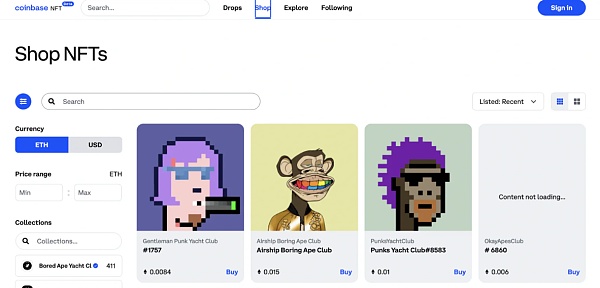
Coinbase NFT might be considered the most disappointing NFT marketplace launch ever. The platform was announced in October 2021, but will not be publicly available until April 2022. In the first three months of launch, Coinbase NFT sales failed to exceed $1 million, and only 1,200 people signed up. Its "Social NFT Marketplace" allows users to friend and comment on NFTs with other customers, similar to a social media platform. Nevertheless, by the end of 2022, Coinbase NFT still has not caused the slightest disturbance in the NFT field.
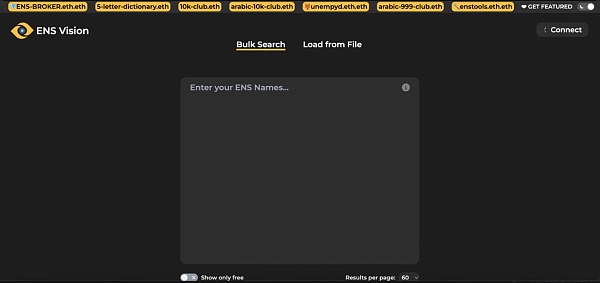
ENS Vision was launched in March 2022 as a tool to help ENS enthusiasts search for ENS names. Over the next few months, ENS experienced a frenzy. ENS Vision saw and capitalized on this opportunity as the transaction volume and demand for ENS became too much for integrated NFT marketplaces such as OpenSea. ENS Vision is currently the leading ENS marketplace with low marketplace fees and additional tools not available in other marketplaces.
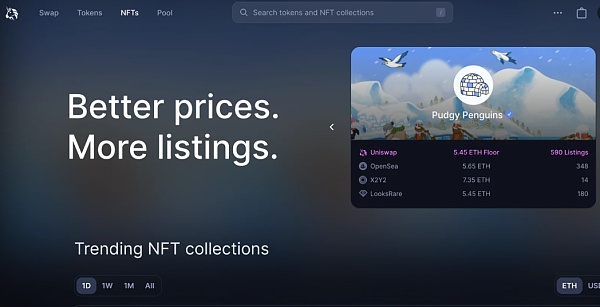
Top decentralized exchange Uniswap acquired NFT Aggregator and Floor Sweeper Genie in June 2022, indicating its intention to enter the NFT market. With its experience developing decentralized trading platforms, Uniswap is expected to become the top NFT marketplace over time. There are indications that Uniswap will allow multiple ERC-20 tokens to be used to buy NFTs, which could give it a significant advantage in the market.
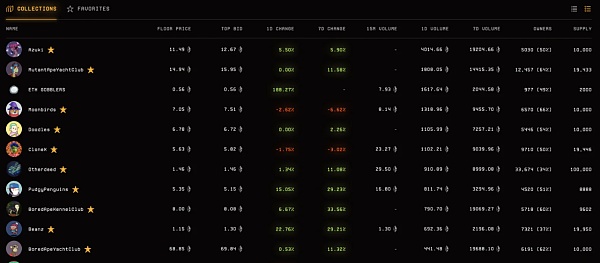
Blur raised $11 million in seed funding in early 2022 led by Paradigm. Until October 2022, Blur launched NFT Marketplace, a platform with a data-driven user interface built for professional traders. It is the first NFT marketplace to offer both an NFT aggregator and a marketplace. With 0% marketplace fees and optional creator “tips,” and an airdrop incentive for BLUR tokens in January 2023, Blur is quickly becoming the top NFT marketplace. However, it remains to be seen whether the platform is sustainable beyond the initial token incentives.
This is a brief history of the NFT market!
More than a decade has passed since the first non-fungible asset "bitcoin.bit" was created on the Namecoin blockchain on April 21, 2011. It's been a wild history, and it's clear that interest in the history of NFTs will only grow over time. It will be interesting to see how the NFT market evolves and what new stories emerge as we move forward.
According to the "Notice on Further Preventing and Dealing with the Risk of Hype in Virtual Currency Transactions" issued by the central bank and other departments, the content of this article is only for information sharing, and does not promote or endorse any operation and investment behavior. Participate in any illegal financial practice.
risk warning:
According to the "Notice on Further Preventing and Dealing with the Risk of Hype in Virtual Currency Transactions" issued by the central bank and other departments, the content of this article is only for information sharing, and does not promote or endorse any operation and investment behavior. Participate in any illegal financial practice.


